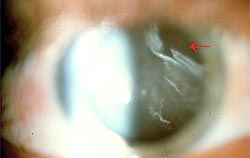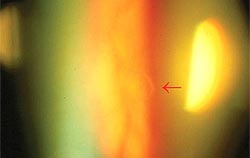Carefully differentiate PVD from retinal breaks
Posterior vitreous detachment is a common finding in the optometric practice, and knowing what signs could indicate the risk of subsequent retinal tear or detachment in the acute presentation is vital for the patient’s health.
Posterior vitreous detachment (PVD) is an age-related change in the eye and occurs among patients older than 55 years. According to Leo P. Semes, OD, a member of the Primary Care Optometry News Editorial Board, “Everyone will develop PVD sooner or later; it’s just a matter of risk factors and time.”
Myopic patients develop PVD earlier
 Randall Thomas |
Myopic patients may develop PVD earlier than patients who are hyperopic. According to Randall Thomas, OD, MPH, FAAO, also a member of the PCON Editorial Board, “Patients who are myopic tend to go to vitreous detachment a little bit earlier than people who are not. The most common incidence of PVD occurs between 55 and 65 years old, and the early 60s is the most common time for it to occur. Therefore, people who are considerably nearsighted will go to PVD approximately 5 to 8 years earlier than people who are not nearsighted.”
Diagnosing retinal tear or detachment
According to Dr. Semes, of all patients who experience PVD, only half will experience symptoms such as flashing lights or floaters. Of the acute symptomatic patients, as many as 10% will have a complication. Complications in the peripheral retina include retinal break or hemorrhage, he said. Macular hole may develop as a complication when persistent vitreomacular traction is present.
 Leo P. Semes |
“Symptomatic patients deserve a dilated fundus exam, and what we look for specifically is any retinal breaks or blood,” Dr. Semes said in an interview. “Sometimes either of those situations could signal the possibility of a subsequent retinal detachment from a specific type of retinal break called a tear.
“In addition, signs of retinal detachment include the presence of red blood cells or retinal pigment (tobacco dust or Shafer’s sign),” he continued. “These are most frequently seen in the immediate retrolental space or in front of the optic disc.”
Clinicians should suspect a retinal tear or detachment if patients report an abrupt increase in the size or number of floaters or flashes, Dr. Thomas told PCON in an interview.
According to information on the Web site of the Good Hope Eye Department, operated by the National Health Service in the United Kingdom, blurred vision or a “curtain” falling across the line of sight, often from below, can also indicate a retinal detachment. Patients should be seen within 24 hours if this is the case; early intervention may allow treatment of a tear and increase the chances of recovery.
No treatment for PVD
There is no treatment for PVD, and patients who are symptomatic must be carefully monitored for 2 to 8 weeks to ensure the retina and macula are still intact.
According to Dr. Thomas, “A key clinical pearl is to always contrast and compare the vitreous in the noninvolved eye, because there can be some vitreal ‘noise’ or nonpathogenically related debris,” he said. “If the exam is normal, as it is 90% of the time, I always stress to the patient to return within a day or two if they experience any increase in their symptoms.”
Within 6 months after PVD, patients should see the vitreous calming and the floaters settling. If they do not, Dr. Semes recommends another option. If a patient sees one large vitreous floater, laser disruption will break it up to make it smaller and hardly noticeable.
In addition, Dr. Semes also suggests removing the vitreous humor altogether and replacing it. “For patients who are totally intolerant of vitreous floaters, vitrectomy may be offered as an option,” he said.
Risk of epiretinal membrane
With PVD, questions arise over whether there could be a potential epiretinal membrane or macular hole that develops as a result.
According to Dr. Thomas, a patient with PVD is at less risk if the vitreous makes a clean break. “Now that the vitreous has detached, there is no longer any vitreoretinal traction on the macular tissues,” he said.
 |
| The anterior vitreous shows the crenellated hyaloids membrane in posterior vitreous detachment. This is observed with direct illumination at the slit lamp biomicroscope before the precorneal lens is introduced to view the fundus. |
 |
| This Weiss ring is seen at the slit lamp biomicroscope. The focus must be in the vitreous to appreciate this observation. Images: Semes LP
|
However, in some cases, strands of vitreous that remain attached at the macula could cause complications. According to Dr. Semes, “One of the things that happens after PVD is sometimes a few little strands of vitreous remain attached at the macula, and that can give rise to something called vitreomacular traction syndrome. Among the consequences of that are macular membrane, epiretinal membrane formation and macular hole formation.”
Cataract surgery performed after PVD
Dr. Thomas believes that cataract surgery would probably not cause an epiretinal membrane. “There is no real data on that,” he said. “Cataract surgery happens at the front of the eye, anyway; I would think there would be no risk. Most people who are old enough to have cataract surgery already have PVD.”
For more information:
- Leo P. Semes, OD, is a professor of optometry, University of Alabama at Birmingham, and a member of the Primary Care Optometry News Editorial Board. He may be contacted at 1716 University Blvd., Birmingham, AL 35294-0010; (205) 934-6773; fax: (205) 934-6758; lsemes@uab.edu.
- Randall Thomas, OD, MPH, FAAO is a member of the Primary Care Optometry News Editorial Board and can be reached at 6017 Havencrest Ct., Concord, NC 28027; (704) 792-6021; fax: (704) 792-1647; thomasepec@carolina.rr.com.
References:
- A posterior vitreous detachment (PVD). Good Hope Eye Department. June 2008. Accessed October 2008.
- Polkinghorne PJ, Craig JP. Analysis of symptoms associated with rhegmatogenous retinal detachments. Clin Experiment Ophthalmol. 2004;32(6):603-606.
- Retinal tears associated with PVDs. Educators in Primary Eye Care. Accessed November 2008.
- van Overdam KA, Bettink-Remeijer MW, Klaver CC, et al. Symptoms and findings predictive for the development of new retinal breaks. Arch Ophthalmol. 2005;123(4):479-484.
- van Overdam KA, Bettink-Remeijer MW, Mulder PG, van Meurs JC. Symptoms predictive for the later development of retinal breaks. Arch Ophthalmol. 2001;119(10):1483-1486.
